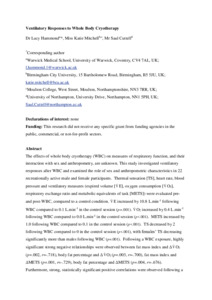Hammond, Lucy and Mitchell, Katie and Cuttell, Saul
(2020)
Ventilatory responses to whole body cryotherapy.
Journal of Thermal Biology, 91.
p. 102633.
ISSN 0306-4565
![[img]](/9633/1.hassmallThumbnailVersion/Hammond%2C%20Mitchell%20%26%20Cuttell%20R2%20%28manuscript%20file%29.pdf)  Preview |
|
Text
Hammond, Mitchell & Cuttell R2 (manuscript file).pdf
- Accepted Version
Download (585kB)
|
Abstract
The effects of whole body cryotherapy (WBC) on measures of respiratory function, and their interaction with sex and anthropometry, are unknown. This study investigated ventilatory responses after WBC and examined the role of sex and anthropometric characteristics in 22 recreationally active male and female participants. Thermal sensation [TS], heart rate, blood pressure and ventilatory measures (expired volume [V˙E], oxygen consumption [V˙O ], respiratory exchange ratio and metabolic equivalents of task [METS]) were evaluated pre- and post-WBC, compared to a control condition. V˙E increased by 10.8 L.min following WBC compared to 0.1 L.min in the control session (p=.001). V˙O increased by 0.4 L.min following WBC compared to 0.0 L.min in the control session (p<.001). METS increased by 1.0 following WBC compared to 0.1 in the control session (p<.001). TS decreased by 2 following WBC compared to 0 in the control session (p<.001), with females' TS decreasing significantly more than males following WBC (p=.001). Following a WBC exposure, highly significant strong negative relationships were observed between fat mass index and ΔV˙O (p=.002, r=-.718), body fat percentage and ΔV˙O (p=.003, r=-.700), fat mass index and ΔMETS (p=.001, r=-.729), body fat percentage and ΔMETS (p=.004, r=-.676). Furthermore, strong, statistically significant positive correlations were observed following a WBC exposure between BSA to mass ratio and TS (p=.005, r=-.669), TS and BSA (p<0.001, r=.776) and fat free mass index and TS (p=.001, r=.745). A short exposure to WBC elicits a ventilatory response via increased V˙O , V˙E and METS. The largest increases occur within the first minute post-exposure, but return to near resting levels 1 min post-WBC. Increases in V˙O , V˙E and METS observed post-WBC are likely due to an acute transient shivering response due to cold air exposure. [Abstract copyright: Copyright © 2020 Elsevier Ltd. All rights reserved.]
Actions (login required)
 |
View Item |

 Tools
Tools Tools
Tools